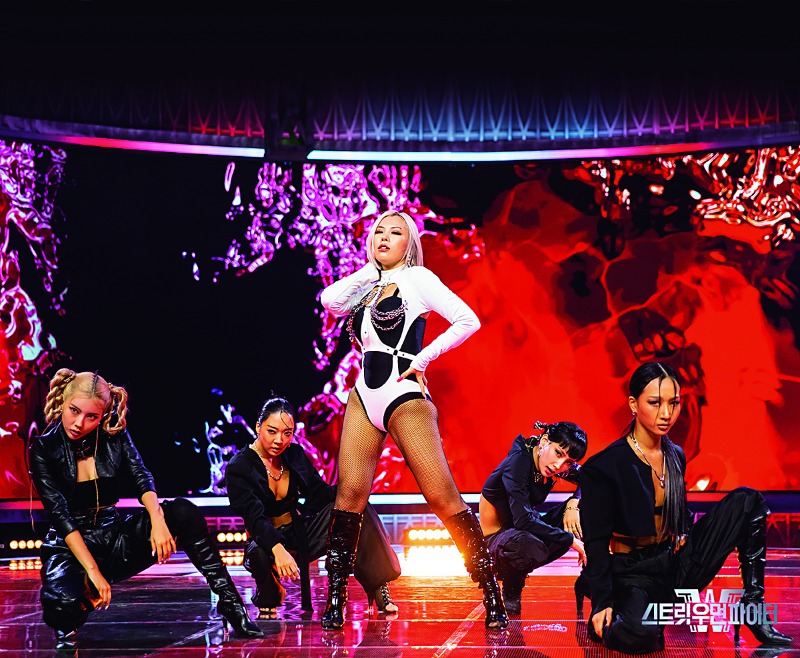TV competition shows featuring only women are gaining traction. A combination of sisterly bonds and empathy superimposed on a narrative of challenging one another while demonstrating mutual respect is winning a special place in viewers’ hearts.

“Street Woman Fighter,” a survival program on the cable TV channel Mnet, put the spotlight on teams of backup dancers, generating extensive attention even before its premier in August 2021. The group in the photo, Holy Bang, was the winner.
© Mnet
When female backup dancers dropped their anonymity and moved to the front of the stage as competitors on the TV contest program “Street Woman Fighter,” they became an overnight sensation on social media and news websites. Premiering in August 2021, the show was the No. 1 trending program in the non-drama category during its two-month run.
By conventional rating standards, “Street Woman Fighter” was mediocre at best. The broadcaster, Mnet, never reached more than 3 percent viewership with it. That sharply contrasted with the same cable network’s “Superstar K” and TV Chosun’s “Mr. Trot,” both music audition shows. The former, which began in 2009 and ran until 2016, was the most popular TV talent hunt during the first three of its eight seasons. It launched several new singing careers. Meanwhile, in 2020, the latter program cashed in on the Korean trot music craze to become one of the highest rated shows ever on Korean cable TV. It built on an earlier show, “Miss Trot.”
What “Street Woman Fighter” did share with its talent show predecessors was a feverish fandom. After the season ended on October 26, the dancers appeared as guests on popular entertainment shows and were featured in yearend magazine stories.
Another program taking the unusual approach of having an all-female cast is SBS’s “Kick A Goal,” which features a mini-football league of middle-aged celebrities coached by members of the celebrated Korean 2002 World Cup team.
Premiering in June 2021, the show led its Wednesday nighttime slot for six consecutive weeks with average ratings of 6-8 percent, markedly higher than other new entertainment programs.
The show’s reputation was blemished when its production staff was caught manipulating footage to make matches look closer than they were in reality.
Still, the program has played its part in injecting new excitement into TV entertainment.
Seen from this perspective, it would be safe to say that the “syndrome” d by “Street Woman Fighter” and the consistent high ratings of “Kick A Goa l” heralded the arrival of female-centric competition shows.
DEFYING CLICHÉS

Prowdmon’s leader Monika (left) and CocaNButter’s leader Rihey. The trailer tried to accentuate the catfights among “alpha girls” and a series of shocking confrontations, but the dancers on the show were coolness itself, respecting and recognizing one another beautifully.
© Mnet

The dancers faced off on a square stage, overseen by the show’s host and three judges. Other competitors sat around the stage cheering and reacting.
© Mnet
“Street Woman Fighter” and “Kick A Goal” are similar in terms of impact.
They each have a winner-takes-all format and break nearly all the rules of female roles in contest shows. Until 2021, the genre was full of gender clichés.
Producers and directors steered shows toward personal rivalry among female competitors, hooking viewers into focusing on personalities, heated arguments and backbiting instead of the competition itself. Typical viewer comments thus descended into patronizing statements such as, “She fights pretty well for a woman.”“Street Woman Fighter” began with this same clichéd formula: the marketing tagline before the first episode was “Summer of 2021, the women are coming to beat you up with their dance!” Trailers portended fierce catfights.
In the first mission given to the cast, a contestant deemed to be inferior was forced to wear a “No Respect” sticker and was pitted in a dance battle. An idol singer who joined the competition was picked on again and again by the experienced dancers. The situation resembled a pack of hyenas chasing easy prey.
But the dancers competed as groups and the show truly hit its stride with its “class mission.” This required group members tochoreography. No:ze, the leader of the group WayB, was the winner, and the other group leaders threw themselves into relentless practice and scrappy competition to be selected as the principal dancer of No:ze’s choreography.
Bickering and badmouthing ensued, just as was intended for viewers’ attention. But outside of the verbal bouts, the dancers displayed respect and care for one another and commitment to their craft. Even the misplaced idol group singer received unlimited affection and respect all the way through to her elimination.

La Chica was initially a temporary group of three, organized to choreograph for a singer, but stayed on as a team to work on increasing commitments with many other singers. They competed in “Street Woman Fighter” as a fivemember team with two guest dancers.
© Mnet
Commenting on No:ze’s choreography, one of the dancers said, “I could cook up something with that. If I can just memorize the moves.” What she meant was not that the dance was easy, but rather that she had conviction in herself and her dance. Although the producers tried to take advantage of editing to portray more emotional catfights among the dancers, the dance groups’ sincere passion came through, and this is what ended up moving the viewers. It was unscripted, but the dancers’ professionalism swung the narrative in a different direction.
The first group to be eliminated was WayB, and leader No:ze left the stage with a smile saying, “I hope that everyone can always dance happily,” a calmof her love of dancing.
From that moment on, winning or losing didn’t matter anymore. It was about proving professionality without any regrets. A strong contender, Prowdmon, fell short during the fourth mission, but viewers didn’t dwell on her defeat.
In a unique redirection for a survival program, it no longer mattered much who would be the eventual winner.
The same has been true of “Kick A Goal,” which became a regular program after the pilot recorded high ratings of 10 percent. Previous shows involving celebrities playing sports gave viewers an opportunity to jeer and laugh at the stars’ lack of ability and fitness. “Kick A Goal,” however, defied expectations, just like “Street Woman Fighter.” FC Fire Moth, a team comprised of middle-aged female celebrities who had won in the pilot program, repeated their feat in the regular season of the show. But, once again, the outcome took a backseat with viewers. The process mattered most. Winning or losing wasn’t important; it was more of an afterthought.
The championship was a rematch against the FC Giants, whose members were fashion models and naturally taller than their opponents. That meant the agility of individuals was more of a challenge. In the pilot program against FC Fire Moth, the fashion models were hopelessly outmatched. However, in the regular season, they played well enough to advance in the playoffs to face FC Fire Moth. Despite losing again, the FC Giants’ tenacity deeply moved viewers. The ps’ assiduous effort on the football field was what caught attention – not their personal disputes or athletic ability.

As a subsidiary dance label under YG Entertainment, YGX has mostly performed behind YG singers or taught the company’s trainees. The team drew attention as the youngest competitors on the show. With their bubbly image, they became the symbol of Gen-Z women.
© Mnet
SOLIDARITY AND EMPATHY
In the entertainment universe of physical matchups, all-female casts are decisively trending ahead of male-centric alternatives precisely because women are challenging the tired programming formulas. They have competed with authentic sincerity, tenacity and mutual respect. The best line to come out of “Street Woman Fighter” was, “Watch now, it’s going to be a fight between the eonni”, referring to an arena of strong, proud women that no man could dare enter. Among the groundbreakers for such female-centric entertainment programming were Echannel’s “Sporty Sisters,” which premiered in 2020 and had a follow-up second season in 2021, and MBC every1’s “Video Star,” which aired from July 2016 to October 2021.
In “Sporty Sisters,” active and retired athletes, including LPGA Hall of Fame golfer Pak Se-ri, attempted a different sport or activity. The show upended stereotypical images of women; swimmer Jung You-in, for example, left a strong impression with her muscular build and wide shoulders.
Similarly, in “Kick A Goal,” comedian Kim Min-kyoung displayed physicality and coordination, brushing off defenders with her sturdy build and charging downfield with fast dribbling that pulled viewers out of their seats. In a wider societal context, where Korean women face conventional expectations and persistent glass ceilings, this image reset is particularly meaningful.
Talk show “Video Star,” an offshoot of MBC’s “Radio Star,” which had an all-male panel until very recently, was also an important contributor.
During the five years that it aired, the female emcees, Park Na-rae and Kim Sook, won the 2019 MBC Entertainment Awards and the 2020 KBS Entertainment Awards, respectively. Long overshadowed by and overlooked in favor of their male counterparts, the two female TV hosts waited many years for their seats at the table and finally gained recognition.
In TV broadcasts, women have consistently been placed in rigid roles and easily marginalized. But female entertainers, both professional and amateur, have increasingly broken new ground against all odds. And of course, there are the female viewers who have empathized with and rooted for them. Having fought similar battles, these women share a sense of solidary. They realize more work needs to be done and are bracing for another bout. Their achievements have not yet peaked; this is an ongoing process. And it seems they have much more to show in 2022.